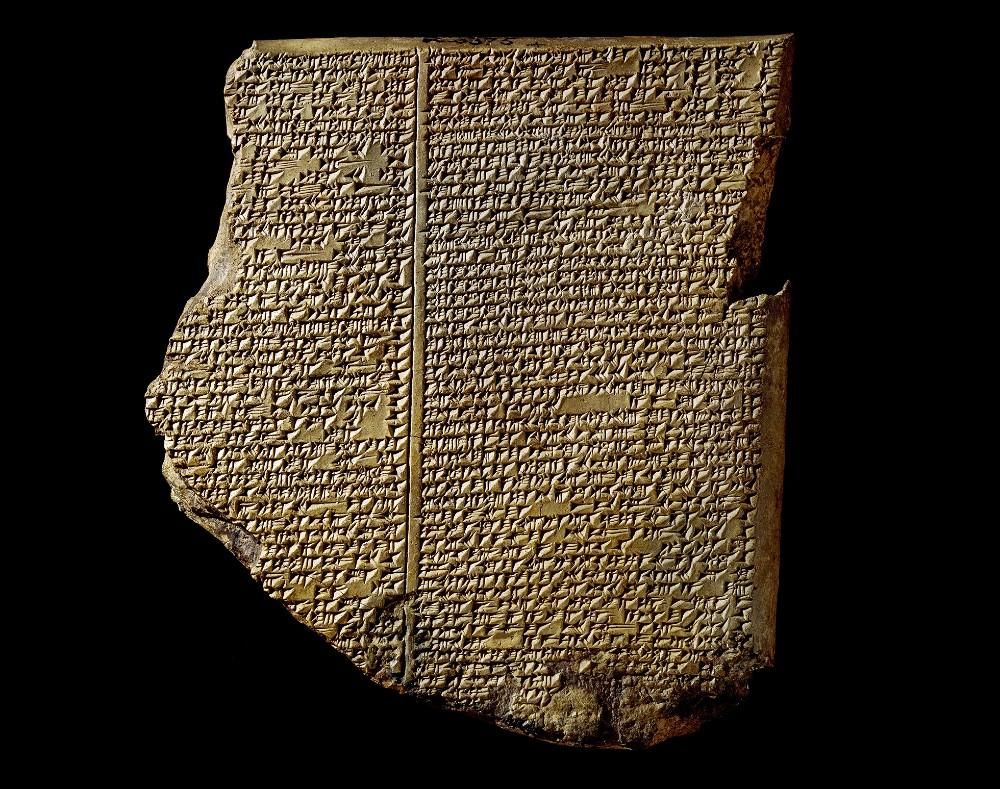Cuneiform, the world’s first writing system, is a fascinating window into the lives of our ancestors.
Developed over 5,000 years ago in Mesopotamia, cuneiform was used to record everything – including everyday transactions, personal letters, and epic poems, like the Epic of Gilgamesh.
Today, it leaves historians and archaeologists with an invaluable source of information about ancient history, literature, religion, and science.
One might picture a scribe living in ancient Babylon, carefully etching the wedges onto a clay tablet as the sun sets around him.
Understanding cuneiform and its history allows us to unlock not only the thoughts, secrets, and sagas of such a scribe; but those of an entire ancient world.

The Origin of Cuneiform Writing
Cuneiform is the earliest known writing system that we know of today. It was originally developed in ancient Mesopotamia for the Sumerian language around 3500 BC.
While the Sumerians were the earliest known users of cuneiform writing, the earliest written records in ancient Sumer are pictographic tablets from Uruk. This early form could only express the basic ideas of concrete objects.
However, the need to represent proper names would eventually bring about the use of pictographic shapes to evoke in the reader’s mind an underlying sound – phonetic writing.
Few physical examples of proto-cuneiform survive from its earliest period – between 3200 and 3000 BC – but by the middle of the third millennium BC, cuneiform was everywhere, utilized for all things economic, religious, political, literary, and scholarly.
Over time, the cuneiform script evolved and was used for various languages beyond Sumerian, like Akkadian, Hittite, and Elamite.
As far as modern archaeology has uncovered, the latest known use of cuneiform was likely around 75 AD, after which the script is thought to have fallen out of use. It was completely forgotten until its rediscovery and decipherment in more modern times.
Its Discovery and Decipherment
Early attempts at cuneiform decipherment date back to medieval Arabo-Persian historians.
Later in the 15th century, European explorers like Giosafat Barbaro, Antonio de Gouvea, and Pietro Della Valle recorded and publicized the early writing systems, including Old Persian inscriptions.
Later, in 1638, Sir Thomas Herbert from England claimed cuneiform as legible and intelligible, and the linguist Thomas Hyde coined the term “cuneiform” in 1700.
The race to decipher and translate cuneiform inscriptions would quicken throughout the late 1700s and into the 1800s.
Finally, the script was cracked open with the identification of the word “king” and the name of the great Persian king, Darius the Great, by Georg Friedrich Grotefend.
Old Persian cuneiform would be successfully deciphered by linguists, historians, and archaeologists across Europe, followed by the cuneiform scripts in other languages such as Elamite, Babylonian, Akkadian, and Sumerian.
Deciphering cuneiform inscriptions took decades of intense, dedicated work by hundreds of scholars, but in the end, their findings opened an entirely new world to the annals of history.
Clay Tablets and a Written Language
But how did cuneiform work? How did the ancient Mesopotamians write it?
In short, cuneiform writing is logo-syllabic, meaning each of its written symbols – themselves composed of wedges pressed into the soft clay by a reed stylus – is representative of a spoken syllable or of a certain character or word.
Since the Sumerian language was monosyllabic, the cuneiform signs typically represented syllables, resulting in a word-syllabic script.
The writing became increasingly complex as time passed, and the pictographs evolved into conventionalized linear drawings.
The writing system developed in stages, starting with pictographs and abstract signs and progressing to the more well-known wedge-shaped signs.
As cuneiform transitioned from pure words to a partially phonetic script, the ‘rebus principle’ became necessary, where pictographic shapes were used to evoke an underlying sound form rather than the basic notion of the drawn object.
With time, the written script would become quite complex. Still, until the first century AD, written Sumerian continued to be utilized as a scribal language. The spoken language, on the other hand, eventually died out around 2000 BC.
Clay tablets were the most common writing material, and as a result, the marks took on a wedge shape from the slanted edge of a stylus.
About 6,000 of these early cuneiform tablets have been discovered, while hundreds of thousands of later, more developed cuneiform tablets are housed in museums worldwide.
Cuneiform’s Regional Influence
The Sumerian script became a complex system that could express just about any topic of human endeavor, and the written word quickly evolved into the backbone of a growing civilization.
It even played a crucial role in disseminating writing to neighboring regions, such as Egypt, with its Egyptian hieroglyphs and the Indus Valley, where writing appeared not long after on official seals featuring individuals’ names and titles.
Cuneiform was adopted by many of these neighboring Mesopotamian and ancient Near East cultures, each of whom adapted it to their different languages.
For example, Linear A and B, the phonetic scripts of Crete and mainland Greece, were likely influenced in this way.
In many ancient societies, cuneiform was used at many levels, from basic functional knowledge for average citizens to technical use for medicine, math, and business.
It could even be considered a complex skill and art form for scholars and played a significant role in Babylonian scribal education.
Ultimately, cuneiform played a crucial role across the ancient Near East.
Legacy and Importance
Cuneiform is largely regarded as the ancient Sumerian culture’s most important and influential contribution. Its creation spurred the birth of literature, allowing for legendary epics, like the Epic of Gilgamesh, to be recorded for all time.
Moreover, the historical significance of cuneiform lies in its role as a precursor to modern writing. Its ability to record and preserve critical information about ancient societies and civilizations enables us today to understand what life must have been like then.
Cuneiform provides not just a window into the past, but in its time, it represented a new technology, driving civilization and history ever forward.
Sources
“Cuneiform.” Encyclopædia Britannica, Encyclopædia Britannica, Inc., 1 Jan. 2023, https://www.britannica.com/topic/cuneiform.
F., Walker C B. Reading the Past: Cuneiform. Univ. of California Press, 1988, Internet Archive, https://archive.org/details/Walker.C.ReadingThePastCuneiform/mode/2up, Accessed 27 Feb. 2023.
Radner, Karen, and Eleanor Robson. “Introduction.” The Oxford Handbook of Cuneiform Culture, Oxford University Press, Oxford, 2020, pp. xxvi-xxxii, https://academic.oup.com/edited-volume/27992/chapter/211695261. Accessed 27 Feb. 2023.
Spar, Ira. “The Origins of Writing.” The Met’s Heilbrunn Timeline of Art History, The Metropolitan Museum of Art, 1 Jan. 1AD, https://www.metmuseum.org/toah/hd/wrtg/hd_wrtg.htm.
Watkins, Lee, and Dean Snyder. “The Digital Hammurabi Project.” Digital Hammurabi Project, The Johns Hopkins University, 2003, https://pages.jh.edu/dighamm/version2/.

